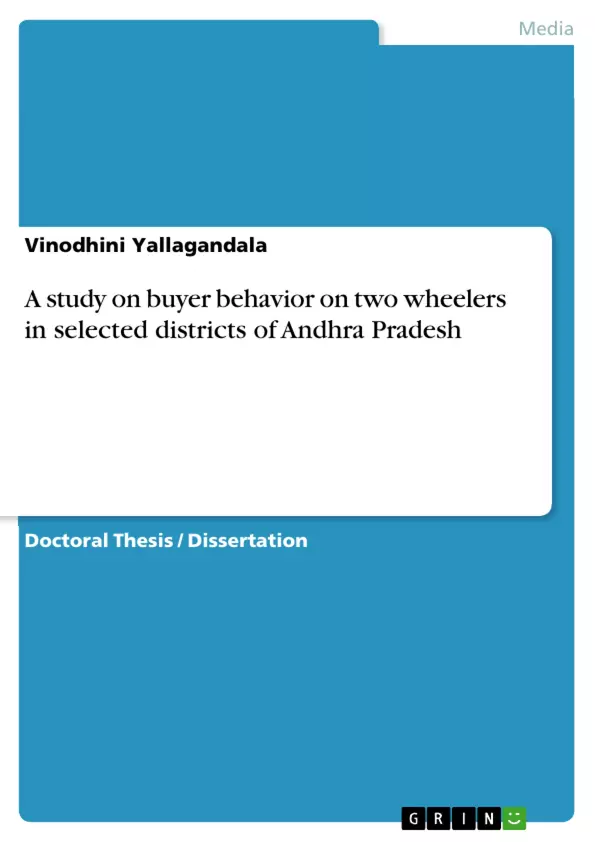Everyone in this world is a consumer we need a variety of goods and services. Time was when people used to get surprised when some consumers droves a two-wheeler. The option of riders was very limited or limited to a small percentage of the total two-wheeler market. Not all buyers are two-wheeler consumers, and then who are those consumers? In addition, how they behave while purchasing a two-wheeler is very important for the marketers. Walter says that buyer behavior is the process whereby individuals decide what, when, where, how and from whom to purchase goods and services.
The study of consumer behavior, therefore, includes an understanding of physical activity of buying as well as mental decision process involved in the purchase outcome. On one side, intermeshing of various demographic and psychographics features in consumers pose several challenges and opportunities to marketers. And stiff competition among sellers and the availability of a wide array of products increase complexities for a consumer and hence, involvement in buying. Though marketers are chiefly interested in the "physical act of buying" by a consumer, yet, the market conditions impel them to study the "mental decision process" undergone in reaching the decision along with.
Table of Contents
- INTRODUCTION (INTRODUCTION TO THE STUDY, PURPOSE OF THE STUDY, SIGNIFICANCE OF THE STUDY, OBJECTIVES OF THE STUDY, RESEARCH METHODOLOGY AND PRESENTATION OF THE STUDY).
- PLAN AND REVIEW OF LITERATURE
- CONSUMER BEHAVIOUR - CONCEPTUAL FRAMEWORK
- TWO-WHEELER INDUSTRY PROFILE
- DATA ANALYSIS AND INTERPRETATION FINDINGS
- RECOMMENDATIONS
- BIBLIOGRAPHY
Objectives and Key Themes
This study aims to understand the buying behavior of consumers towards different two-wheeler brands in select districts of Andhra Pradesh. It examines the factors influencing purchasing decisions, including brand image, price, technology, and servicing. By understanding consumer preferences, the study seeks to identify areas where improvements are required to enhance customer satisfaction and market share.
- Consumer behavior in the two-wheeler industry
- Brand image and market share of two-wheeler brands
- Factors influencing purchasing decisions in the two-wheeler segment
- The impact of price, technology, and servicing on consumer preferences
- Opportunities for improvement in the two-wheeler market
Chapter Summaries
- Chapter-I: Introduction: This chapter introduces the study and provides context for the research. It highlights the significance of understanding consumer behavior in the two-wheeler industry, the growth of the sector, and the increasing competition among various brands. It also emphasizes the importance of identifying consumer needs and preferences to effectively cater to the market.
- Chapter-II: Plan and Review of Literature: This chapter outlines the research methodology and presents a comprehensive review of existing literature on consumer behavior in the two-wheeler industry. It explores previous studies, theories, and frameworks relevant to the topic, providing a foundation for the research.
- Chapter-III: Consumer Behavior - Conceptual Framework: This chapter delves into the conceptual framework of consumer behavior, examining the factors influencing purchasing decisions. It analyzes the interplay of demographic, psychographic, and behavioral factors in shaping consumer preferences. The chapter also discusses the decision-making process involved in the purchase of a two-wheeler.
- Chapter-IV: Two-Wheeler Industry Profile: This chapter provides an overview of the two-wheeler industry, highlighting its structure, key players, and market trends. It examines the competitive landscape, market segmentation, and the dynamics of the industry. The chapter also analyzes the current state of the industry, including the challenges and opportunities faced by manufacturers and distributors.
- Chapter-V: Data Analysis and Interpretation Findings: This chapter presents the findings of the study based on data analysis and interpretation. It analyzes the collected data to identify key insights into consumer behavior towards different two-wheeler brands. This includes examining the factors influencing purchase decisions, brand preferences, and satisfaction levels.
Keywords
The study focuses on consumer behavior, two-wheeler industry, brand image, market share, purchasing decisions, price, technology, servicing, customer satisfaction, and market trends.
- Citar trabajo
- Dr. Vinodhini Yallagandala (Autor), 2010, A study on buyer behavior on two wheelers in selected districts of Andhra Pradesh, Múnich, GRIN Verlag, https://www.grin.com/document/537745



